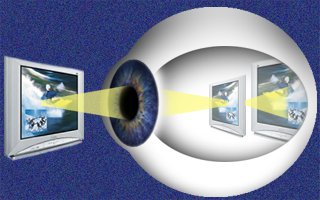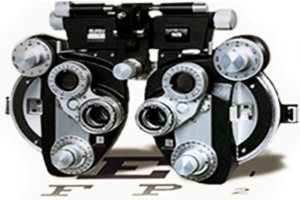|
Myopia - (Nearsightedness)
Myopia is the medical term for
nearsightedness. Nearsighted eyes are good at seeing objects
that are up close but have trouble seeing objects that are far
away. This is due to a refractive error in the eye.
Refraction is the bending of light. When a light wave enters the
eye, it is bent by the cornea as it makes its way through to
land on the retina. There are two different factors that can
contribute to myopia: the curvature of the cornea and the length
of the eye. If the curvature of the cornea is too great, the
light beam lands on the wrong part of the eye. Similarly, if the
length of the eye is too long, the light will land in front of
instead of on top of the retina. Either way, the result is that
far away objects become blurry and out of focus. |
 |
|
Myopia is not an eye disease, but an eye disorder. Because of the
role refraction plays in this type of nearsightedness, myopia is known
as a refractive disorder.
Causes
Myopia is often inherited from
the parents. Chances are, if your parents wore glasses, you will need
glasses too.
There is also some evidence that an increased amount of
close work may cause myopia. Close work is any kind of work that
involves looking at objects close up, such as typing, reading or sewing.
Other causes include being born premature with a low birth weight,
having an eye disease that is seen along with myopia or having a
condition that causes the eyes to grow larger than is normal.
Onset
and Treatment
Myopia appears in children between the ages of eight
and twelve and may worsen as the body grows throughout the teenage
years. Between the ages of 20 and 40, there may be little or no change
in vision. After 40, vision may begin deteriorating again. The onset of
myopia may be slow and gradual, or rapid and sudden. Every case is
unique to the patient.
The first signs of myopia often become
noticeable when a child has a difficult time reading a chalkboard, or
seeing the teacher clearly but
has no trouble reading his textbook.
Other signs are the decreased
clarity of a distant TV screen, problems driving at night or blurred
vision at the cinema. Squinting is an outward sign that a child may need
to be examined for myopia.
They might also sit closer to the television,
rub their eyes frequently or hold a book very close to their face. It is
important to have your child tested for myopia as there are educational
and social consequences they may suffer due to decreased vision that
remains uncorrected. |
 |
A child may be too embarrassed to complain of
vision problems or they might be unaware of the changes in their vision,
emphasizing the need for regular eye exams for children. Every one to
two years in school age children helps catch vision problems early on
before they have a chance to affect the child’s schoolwork or their
social life.
Common options for treatment are the use of glasses
or contact lenses. There are other options for myopia which include:
•
Orthokeratology, also known as corneal refractive therapy: a
re-shaping of the cornea using rigid gas-permeable contacts. These
contacts rest on the surface of the eye and gently re-shape the cornea.
Altering the curvature of the cornea restores proper vision in the eye.
•
Laser eye surgery:
A surgical procedure where vision is corrected
by removing a small part of the eye with a laser. Using a highly focused
laser beam, a professional cuts away a bit of eye tissue, flattening the
cornea and correcting the focus.
Advanced Treatment
In
particularly bad cases of myopia, known as high myopia, surgery may be
necessary. There are some refractive surgery procedures that can correct
vision in extreme cases of myopia.
•
Phakic intraocular lenses:
These are thin lenses that are implanted into the eye, eliminating the
need for contacts or glasses. They sit right in front of the natural
lens and help the eye focus light onto the retina, which allows far away
objects to be seen clearly.
•
Intraocular lens transplant with
clear lens extraction: A surgical procedure where the eye’s natural lens
is replaced by an implant. The natural lens is removed, and a synthetic
lens is put in its place. This allows most people to achieve 20/40
vision or better over time.
Diagnosis
A diagnosis of myopia can be
made by taking a classic vision test under the supervision of an
optometrist or ophthalmologist. A person who is nearsighted will have an
easy time reading the letters on a Jaeger eye chart (the close objects
chart) but a hard time with a Snellen chart (the far objects chart).
If a problem in the patient’s vision is detected during the eye chart
test, the retina may be examined using a retinoscope. This device shines
light on the patient’s retina so the doctor can examine it and find the
issue causing problems with the patient’s vision.
When other causes
of nearsightedness, such as eye disease, are ruled out and the problem
with vision is determined to be a refractive error, the doctor will use
a phoropter. This is the machine that allows the doctor to show a series
of lenses to a patient, switching back and forth between them to
determine the best fit for corrective lenses. |
 |
Risks
People with
myopia are at a higher risk for glaucoma and cataracts.
They also
have a higher than average chance of having a detached retina. If you
notice a sudden change in vision, a loss of central vision, a large
increase in the amount of floaters (squiggly, transparent shapes that
“float” across the eye), or sense a feeling of heaviness in one eye,
this could be a sign of a detached retina. Immediately seek treatment
from a medical professional. Early treatment could prevent further
complications.
Prevention
There are no proven methods for
preventing myopia. Some controversial measures include under-correcting
vision and using a series of eye exercises to strength the eye. Neither
has been conclusively proven in research studies. There are some
studies being done that show children who spend more time outdoors in
the sun develop myopia at a slower rate.
Because of the known ties
between close work and myopia, it is best to limit the amount of time
children spend close to a screen and make sure that any areas where
close work is performed, such as a desk or computer station, are
well-lit. Give your eyes a break. Take frequent "eye rests" by staring into the
distance about every 10 minutes or so for about 30 seconds when performing close work.
This action may also
help prevent eye strain.
When to see an eye care professional
Those under forty years in age, should have regular schedules checkups
about once every two years unless otherwise instructed by your eye care
professional. Those over forty should go once every year unless
otherwise instructed by your eye care professional. Outside of your
regular check ups, if you
notice you or your child is squinting a lot or sitting closer to the TV, or if
you or they complain about blurry vision when it comes to far away objects,
you or they may be developing myopia and should be examined by an eye doctor.
Always see an eye care professional immediately if you have any sudden
changes in vision. This includes darkening around the edges of your
vision, dark spots in front of your eyes, halos around bright lights, a
loss of vision in one part of your field of sight or any other
noticeable change.
|